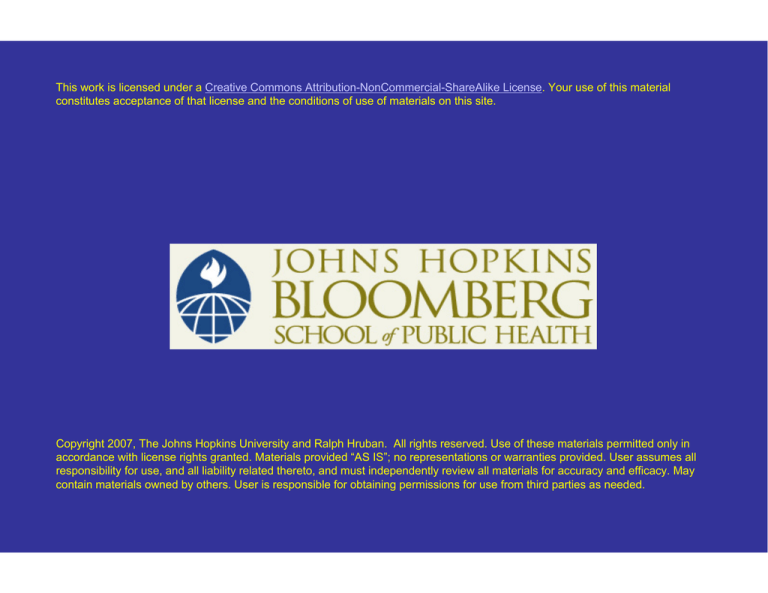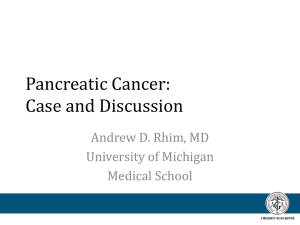
This work is licensed under a Creative Commons Attribution-NonCommercial-ShareAlike License. Your use of this material
constitutes acceptance of that license and the conditions of use of materials on this site.
Copyright 2007, The Johns Hopkins University and Ralph Hruban. All rights reserved. Use of these materials permitted only in
accordance with license rights granted. Materials provided “AS IS”; no representations or warranties provided. User assumes all
responsibility for use, and all liability related thereto, and must independently review all materials for accuracy and efficacy. May
contain materials owned by others. User is responsible for obtaining permissions for use from third parties as needed.
Pancreatic
Cancer
Ralph H. Hruban, M.D.
Professor of Pathology and Oncology
The Sol Goldman Pancreatic Cancer Research Center
The Johns Hopkins Medical Institutions
Outline
•
•
•
•
•
•
•
What is the pancreas?
What is pancreatic cancer?
How do we diagnose pancreatic cancer?
How do we treat pancreatic cancer?
What are the known risk factors?
What is the prognosis?
How can we beat pancreatic cancer? (precursors,
genetics, screening)
What is the
Pancreas?
Public Domain
Public Domain
How do we Diagnose Pancreatic
Cancer?
•
•
•
•
Computed Tomography
Endoscopic Retrograde Cholangio Pancreatography
Endoscopic ultrasound (EUS)
Biopsy – The gold standard for diagnosis
The Biopsy is the Gold Standard for
Diagnosis
• Perineural invasion
• Lymphatic invasion
• Venous invasion
How do we Treat Pancreatic
Cancer?
• Pancreatoduodenectomy (Whipple Resection)
• Chemoradiation Therapy
– 5-Flurouracil
– Gemcitabine (Gemzar)
What are the Risk Factors for
Pancreatic Cancer?
• Cigarette smoking: For example, smoking during
college has been associated with a 2-3 fold increased
risk of pancreatic cancer.
• Age: The risk of developing pancreatic cancer
increases with age. Over 80% of the cases develop
between the ages of 60 and 80.
• Race: Studies in the United States have shown that
pancreatic cancer is more common in the AfricanAmerican population than it is in the white population.
Some of this increased risk may be due to
socioeconomic factors and to cigarette smoking.
• Gender: Cancer of the pancreas is more common in
men than in women. Men are more likely to smoke
than women.
Risk Factors
• Religious Background: Pancreatic cancer is proportionally more
common in Jews than the rest of the population. This may be
because of a particular inherited mutation in the breast cancer gene
(BRCA2) which runs in some Jewish families.
• Chronic pancreatitis: Long-term inflammation of the pancreas
(pancreatitis) has been linked to cancer of the pancreas.
• Diabetes: Diabetes is both a symptom of pancreatic cancer, and
long-standing adult-onset diabetes also increases the risk of
pancreatic cancer.
• Obesity: Obesity significantly increases the risk of pancreatic
cancer
• Diet: Diets high in meats, cholesterol fried foods and nitrosamines
may increase risk, while diets high in fruits and vegetables reduce
risk. Folate may be protective
• Genetics: A number of genetic syndromes increase risk (BRCA2,
FAMMM, Peutz-Jeghers) as does a strong family history of
pancreatic cancer
Family
History
Cancer as a Complex Phenotype: Pattern of Cancer Distribution
within and beyond the Nuclear Family
L. Amundadottir et al. Cancer as a Complex Phenotype: Pattern of Cancer Distribution within and beyond the
Nuclear Family. PLoS Medicine 2004;1(3):e65
Methods
• Iceland Cancer Registry- All cancer cases
diagnosed in Iceland after January 1, 1955
• 95% of the cancers were histologically
confirmed
• Genealogic database- (deCODE)- 687,500
individuals
• The names of all 288,000 Icelanders
currently alive and a large proportion of all
Icelanders who have ever lived
L. Amundadottir et al. Cancer as a Complex Phenotype: Pattern of Cancer Distribution within and beyond the Nuclear
Family. PLoS Medicine 2004;1(3):e65
National Familial Pancreas Tumor Registry
at Johns Hopkins
• Established 1994, Alison Klein, Director
• Emily Palmisano and Marian Raben
• 2403 Families enrolled (7/15/2007):
– 1537 Non-Familial Kindreds
– 866 Familial Kindreds (>= 2 FDR with PC)
# Affected Members
# of Families
2
3
4
565
203
68
30
≥5
Prospective Pancreatic Cancers
• 56 incident pancreatic cancers have developed in NFPTR
kindreds
• 52 in blood relatives, only four in spouses
• 8 of the 56 were resectable, and most of the resections
revealed lymph node metastases
• One early cancer was detected serendipitously during
imaging for a kidney stone
• Prospective pancreatic cancers help establish the
existence of familial pancreatic cancer and can serve as a
surrogate for gene status
Klein et al, Clin Cancer Res 7:738-744, 2001
Expected Incidence per 100,000 in the General U.S.
Population
350
288
300
250
200
14-
150
100
32X
57.6
41.4
50
9
2.34.6X
6.4X
General Population
1
2
0
3
Number of FDR with Pancreatic Cancer
Data Source: Klein AP, et al. Prospective risk of pancreatic cancer in familial pancreatic cancer kindreds. Cancer Research.
2004;64(7):2634-8
Is it the
environment
or a gene?
Segregation Analysis
A statistical methodology aimed at
determining if a major gene could cause
the observed familial aggregation of a trait.
Segregation analysis can also provide a
model for how this gene is inherited (AD
vs. AR, frequency, penetrance)
Segregation Analysis
• Segregation analysis of 287 families ascertained through
an index case diagnosed with pancreatic cancer at JHMI
• Able to reject non-genetic transmission models
(p<0.0001)
• Most parsimonious models included autosomal dominant
inheritance of a rare allele
• ~0.6% of the population estimated to carry this allele
A. Klein, Genetic Epi, 2002, 23:133-149
Risk of Pancreas Cancer
Individual
Risk
Age 50
Age 70
No History
RR=1
.05%
0.5%
BRCA2
3.5-10x
0.5%
5%
p16
20-34x
1%
10-17%
32x
1.6%
16%
Trypsinogen
50-80x
2.5%
25-40%
Peutz-Jeghers
132x
6.6%
30-60%
Familial PC
BRCA2
BRCA2 and Familial Breast Cancer
• Carriers of the 6174 del T BRCA2 mutation have ~10x
increased risk of developing pancreatic cancer
• ~17% of patients with 3 relatives with pancreatic cancer
have a germline BRCA2 mutations
• ~12% of patients with 2 relatives with pancreatic cancer
have a germline BRCA2 mutations
• ~7% of patients with “sporadic” pancreatic cancer have
germline BRCA2 mutations
Cancer Res 1996;56:5360
Cancer Res 2002, 62:3789-3793
Nat Genet 1997;16:17
J Natl Cancer Inst. 2003;95:214-21.
Familial Atypical
Multiple Mole
Melanoma Syndrome
p16 and FAMMM
• The Familial Atypical Multiple Mole Melanoma
(FAMMM) syndrome is characterized by
multiple nevi, multiple atypical nevi and
multiple melanomas
• FAMMM can be caused by germline mutations
in the p16 gene
• Patients with FAMMM have a 20-34 fold
increased risk of developing pancreatic
cancer
NEJM 1995; 333:970
Peutz-Jeghers Syndrome
• 132 fold increased risk of pancreatic
cancer
Risk of Pancreas Cancer
Individual
Risk
Age 50
Age 70
No History
RR=1
.05%
0.5%
HNPCC
?
?
<5%
BRCA2
3.5-10x
0.5%
5%
Familial PC (3) 32x
1.6%
16%
FAMMM
20-34x
1-2%
10-17%
Pancreatitis
50-80x
2.5%
25-40%
3.6%
36% (age 60)
Peutz-Jeghers 75-132x
“It’s hard to make
predictions, especially
about the future.”
– Yogi Berra
These known genetic
syndromes account for
only 10-20% of familial
pancreatic cancer
What is the Prognosis
for Patients with
Pancreatic Cancer?
Surgically Resected Patients
Cancer in Norway 1958-97. Five-year relative pancreatic cancer survival in percent by
period of diagnosis, sex, and stage
3.5
3.0
Percent
2.5
2.0
1.5
1.0
Male
Female
0.5
0.0
1958-62 1963-67 1968-72 1973-77 1978-82 1983-87 1988-92 1993-97
Data Source: Cancer Registry of Norway. http://www.kreftregisteret.no
How Can we Beat
Pancreatic Cancer?
1. By Understanding
the Precursors to
Invasive Pancreatic
Cancer
What are the precursors to
invasive pancreatic cancer?
• Intraductal Papillary Mucinous Neoplasms (IPMN)
• Pancreatic Intraepithelial Neoplasia (PanIN)
Intraductal Papillary
Mucinous
Neoplasms and
Pancreatic
Intraepithelial
Neoplasia
Pancreatic intraepithelial
neoplasia and intraductal
papillary mucinous
neoplasms are curable
neoplasms and, if left
untreated, some will progress
to infiltrating carcinoma
2. By Understanding
the Genetics of Invasive
Pancreatic Cancer
Genetic profile of pancreatic cancer
■ Gene
% rate of genetic alteration
■ p16
98
■ K-ras(90%) (+ 5% BRAF)
95
■ p53
70
■ DPC4/SMAD4
55
■ BRCA2 (FANC C and G)
7-10
■ Mismatch repair genes
4
■ STK11 (Peutz-Jeghers)
5
■ AKT2, AIB1, c-MYC, cAmplified
MYB
Pancreatic Cancer is
a genetic disease
3. Screening- how
can we find
Precursor
lesions/early
cancers?
There are no Effective
Screening Tests for
Pancreatic Cancer
Sensitivity and Specifity
Needed to Detect a
Disease with an Incidence
of 9 per 100,000 per year
Pancreas cancer is a
disease of inherited
and acquired
mutations





